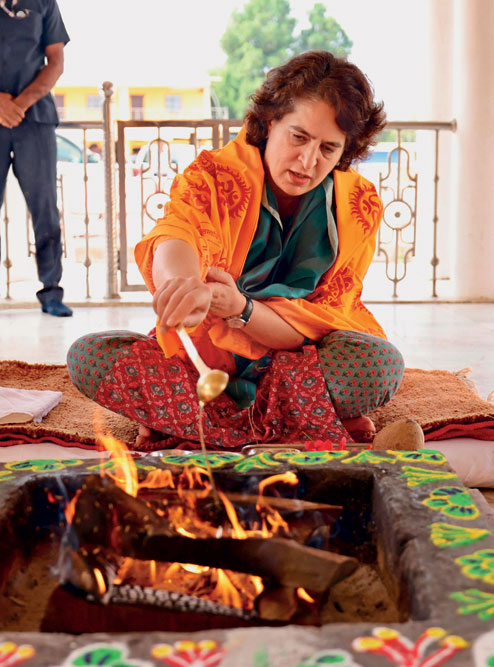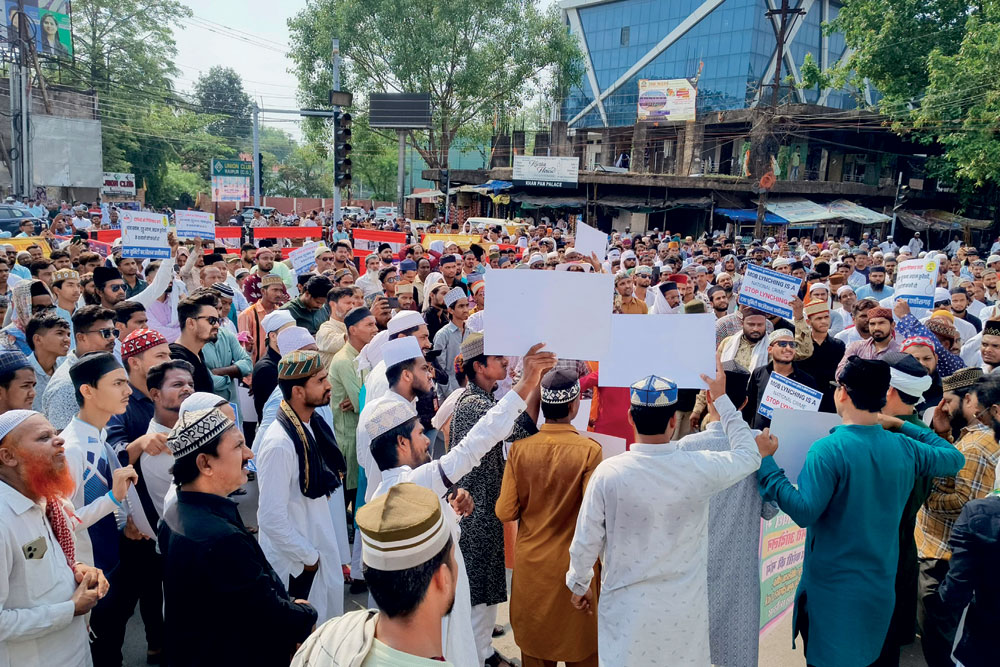The Meem Tightrope
How best can Congress accommodate the Muslim question?
 Rahul Pandita
Rahul Pandita
 Rahul Pandita
Rahul Pandita
 |
05 Jul, 2024
|
05 Jul, 2024
/wp-content/uploads/2024/07/MeemPartners1.jpg)
Rahul Gandhi speaks in Parliament, July 1, 2024
ON JUNE 29, the hardliner Muslim cleric, Sajjad Nomani, speaking at event in Delhi, offered a diagnosis of what he thought afflicted the non-BJP parties when it came to the question of Muslims. Pointing out that leaders like the Samajwadi Party’s (SP) Akhilesh Yadav preferred to use the word alpasankhyak (minority) instead of Muslim, Nomani said he yearned to hear the M-word from Rahul Gandhi’s mouth. “You need his votes, but you are not willing to give him (the Muslim) an equal status,” he said.
Two days later, in his first address as Leader of the Opposition, Gandhi did finally utter it. In his attack aimed at Prime Minister Narendra Modi, Gandhi tried to make a distinction between Hinduism practised by everyday Hinduism and the one he claimed was practiced by the Bharatiya Janata Party (BJP).
“Those who call themselves Hindus, they keep talking about violence, hate, and lies 24 hours a day. You are not Hindus,” Gandhi said, referring to BJP. As Modi rose to his feet saying Gandhi should not target the entire (Hindu) community, Gandhi retorted that Modi and BJP and the Rashtriya Swayamsevak Sangh (RSS) were not the entire community.
The robust attack on the BJP benches has won Gandhi some brownie points among his admirers and even some of those who had not been very hopeful of him. But many, especially among the Muslim community, see this as rather convenient. They point out Gandhi’s reluctance to clearly speak about incidents of violence against the Muslim community. They particularly mention the recent one in Congress-ruled Himachal Pradesh where a Muslim shopkeeper’s premises were ransacked by a mob after he put pictures of animal sacrifice as his WhatsApp status, which the mob believed to be those of a cow. It turned out to be the image of a buffalo from his native place in Uttar Pradesh (UP). It may have been insensitive on the man’s part but, legally, there was no case to be made against him. Yet, looking at the kind of sentiment it evoked among Hindus in the state and elsewhere, the Congress leadership chose to maintain silence on the issue. There have been other incidences of violence against Muslims, including lynching of men by cow vigilantes in UP and Chhattisgarh. In Madhya Pradesh, several homes belonging to the Muslim community were bulldozed. Many among the Muslim community have pointed out the absence of such issues on a list of ‘failures’ of the first 15 days of the BJP-led National Democratic Alliance (NDA) government highlighted by Gandhi on social media platform X. This includes the NEET scam and forest fires and deaths due to heat wave in many areas in India. But there was no mention of violence against Muslims on this list.
What explains this reluctance?
“Congress does not have a principled position on secularism,” says Hilal Ahmed, associate professor at the Centre for the Study of Developing Societies (CSDS), “that is why you will see no hesitation in attacking BJP or RSS, but beyond that Congress wants to play the game of silence.”
The attack on the BJP benches has won Rahul Gandhi some brownie points among his admirers and even some of those who had not been very hopeful about him. But many see this as convenient. They point out Gandhi’s reluctance to speak about incidents of violence against the Muslim community
According to him, Congress’ strategy is to be in the middle of two meanings of Hindutva—one that is purely anti-Muslim and the other in which Hindus like to see themselves in a positive way, without being critical of Muslims, but on top of that they also want tangible things like jobs and development. The biggest example of this is BJP’s defeat in the Faizabad constituency in UP where just a few months ago the Ram temple was inaugurated with much fanfare. “In these elections, the people’s secularism and not the secularism of non-BJP parties is the winner,” Ahmed says.
The new wave of confident belligerence against BJP and particularly Modi stems from this understanding among the Opposition that hardcore Hindutva has not worked this time. A lot of political succour has been drawn from BJP’s defeat in Faizabad and from Modi’s narrow victory margin in Varanasi. This has happened for the first time since BJP came to power in 2014 under Modi. It was followed in 2017 by BJP’s big victory in UP, which led to Yogi Adityanath becoming the state’s chief minister, and then another mammoth electoral mandate in 2019. But this time, BJP fell short of a clear majority.
The aggression against BJP and RSS apart, can Congress really afford to take Hindutva head-on? Especially when, as Hilal Ahmed says, BJP managed to successfully blur the line between Hinduism and Hindutva. BJP’s anti-Muslim strategy, making digs at them by using terms such as ‘infiltrators’, may not have worked this time, eclipsed by issues that affect people more than the idea of an ‘enemy’, but will it work if Congress were to get rid of its hesitation about incidents like the one in Himachal? “It may become counterproductive,” says Tanweer Fazal, professor of sociology, University of Hyderabad. “BJP can play the game of religion much better than anyone else and it has managed to fuse religion and nationalism that works well for it. Any party seen going against it will suffer electorally,” he says.

Scholars like Bhagwan Josh have long made note of it. In an article published in the Times of India on August 4, 1993, Josh had argued that “the historical process of the formation of the Indian nation and nation-state is structured through nationalism—a nationalism which more or less overlaps with the Hindu cultural internality.” Josh writes that Congress has had an encompassing vision of nationalism over what he calls the three codes of mass consciousness: caste, class and community. Barring Congress, other parties would use one of these codes to align themselves with a group of people. The communists, for example, use the class code, while parties like the Bahujan Samaj Party (BSP) use caste. BJP, which was largely seen as aligned with the (Hindu) community code, has in the last few years been able to break into other codes. That is how it made inroads among Dalits and backward castes. They even speak of Pasmanda Muslims, something Congress, again, finds reluctant to talk about, fearing that it will lead to anger among its elite Muslim supporters.
“It is better that Congress raises the issue of Muslims under the broad umbrella of social justice—the one that includes Dalits and other marginalised communities. Because once you enter the religious space, you cannot compete with BJP. And as a political party you cannot afford that,” says Fazal.
The aggression against BJP and RSS apart, can Congress really afford to take Hindutva head-on? Especially when, as academic Hilal Ahmed says, BJP managed to successfully blur the line between Hinduism and Hindutva
Hilal Ahmed points at Rahul Gandhi’s Nyay Yatra earlier this year which he says focused entirely on substantive issues but did not touch upon the question of Hindutva. “In that sense Hindutva remains an open-ended possibility,” he says.
The rise of Hindu awareness or its militancy, as some like to argue, is often attributed to the airing on national television of the epic series Ramayana in 1987-88 (a BBC feature claimed it set the path for a national Hindu consciousness). It is shortly afterwards that BJP’s LK Advani launched his Rath Yatra, and coupled with its posturing on Kashmir, it enabled BJP to finally give a tough fight to Congress. But it is clear that years before its telecast, Congress’ Indira Gandhi had picked up on undercurrents among the majority Hindus about their identity and place in India. In 1983, Congress General Secretary CM Stephen had declared that “the wave length of Hindu culture and Congress culture is the same.” In May that year, Indira Gandhi went a step further. “If there is injustice to them (the Hindus) or if they do not get their rights, then it would be more dangerous to the integrity of the country,” she said.
IN 2024, ALMOST 40 years later, Rahul Gandhi may have chosen to take the same path: trying to take back Hindus from BJP; Hindus who cannot be made permanent voters, like Hilal Ahmed says, on a purely anti-Muslim plank. But for that to happen, Hindus should not feel that the Muslim cause is being addressed at the cost of Hindu cultural internality.

That brings the debate to the vacuity of the term secularism itself when it comes to a country like India where religion plays a prominent role in the lives of people. The religion scholar, Jakob De Roover, calls secularism “a scarcely intelligible idea once one tries to give content to loose talk on the separation of religion from the different domains of public life”. With regards to Hindu internality, Roover wrote in the (September 2002 issue of) Economic and Political Weekly: “When does a state become a Hindu state, as opposed to a secular state? When the government publicly cites Rama as the prototype of the ethical king? Or when it consults an astrologist before making an important political decision? When a puja is done in parliament? Any answer to these and similar questions will be derived from the standard that distinguishes the class of things Hindu from that of things secular. Since there is not the least consensus on such a standard, one can fix it as one chooses, and accordingly one can give one’s own interpretation as to what it means for India to be a secular state.”
The debate on whether the Muslim community reconciles itself with being an overall part of Congress’ umbrella of social justice will only intensify in the coming years. It is not acceptable to hardliners
Moreover nyay or justice should mean the same for all. Congress critics have mentioned Rahul Gandhi’s reluctance to address issues like the beheading of a Hindu tailor in 2022 in Rajasthan at the hands of Muslim extremists. Much before that, the late Congress ideologue VN Gadgil had alluded to this hypocrisy. At a training camp in 2000, as journalist Rasheed Kidwai writes, Gadgil had asked: “Do minorities mean only Muslims? What about Buddhists, Sikhs and others? When 36 Sikhs were killed in Kashmir, not a single Congressman condoled their deaths.”

The debate on whether the Muslim community reconciles itself with being an overall part of Congress’ umbrella of social justice will only intensify in the coming years. It is definitely not acceptable to hardliners like Nomani. In his address, Nomani used the example of the difference between a traveller and a coolie waiting at a railway station. The coolie, he said, waits for the train so that it helps a babu in getting off and making another board it. The traveller, he said, is there to reach his destination. “In the electoral train, most Muslims behave like that coolie,” he said.
The destination, many would argue, is not a problem if it does not infringe upon the destination of other travellers. It is just that the other travellers may want to call it Hindu internality.

/wp-content/uploads/2025/06/Cover-OpenMinds2025.jpg)












More Columns
Puri Marks Sixth Major Stampede of The Year Open
Under the sunlit skies, in the city of Copernicus Sabin Iqbal
EC uploads Bihar’s 2003 electoral roll to ease document submission Open